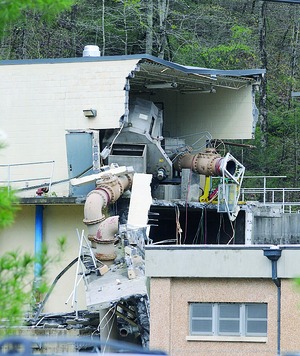
The April wall collapse at a Gatlinburg, Tenn., wastewater treatment plant that killed two workers was caused by deficient construction that allowed gradual corrosion of the rebar inside it, a state safety report said.
The report, written by Mahammad Ayub, director of the federal Occupational Safety and Health Administration office of engineering, and Mary Misciagna, Tennessee Occupational Safety and Health safety supervisor, did not find workplace safety violations, so the state is not issuing citations against the city of Gatlinburg, the plant owner or its operator, Veolia Water North America.
John D. Eslinger, 53, a lead operator, and Donald A. Storey, 44, an operator, were killed on April 5 (ENR 4/13 p. 25) when a 115-ft-long wall section of the equalization basin separated and collapsed onto the flow control building where they were working.
“The cause of the failure was a deficiency in the concrete wall construction,” Ayub wrote in a summary report released on Oct. 27. “Walls were cast in a manner that produced a cold joint between the east wall, which fell, and the three orthogonal interior intersecting walls. The intersecting walls were critical to the structural integrity of the east wall.”
Over the years, that cold joint made possible acidic wastewater leakage that corroded the rebar splice couplers, according to Ayub.
Neither the contractor, Crowder Construction Co., Bristol, Tenn., nor the engineer, Flynt Engineering Co., Knoxville, is in business now, he said.
The equalization basin was built in 1994-96, and the blueprints for the design are dated 1992.
“The contractor used splicing couplers instead of dowels, as required by the original drawings,” but that did not cause the collapse, Ayub said.
Also, “The rebars were not threaded to the required length inside the coupler at all locations,” Ayub said.
The rebar and couplers were not galvanized nor did they have epoxy coating, “which could have prolonged the life of the basin,” Ayub said.

Post a comment to this article
Report Abusive Comment